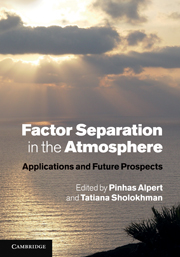Book contents
- Frontmatter
- Contents
- List of contributors
- Foreword
- Preface
- 1 Introduction
- 2 The Factor Separation Methodology and the fractional approach
- 3 Investigation of the Factor Separation features for basic mathematical functions
- 4 Factor Separation Methodology and paleoclimates
- 5 Meso-meteorology: Factor Separation examples in atmospheric meso-scale motions
- 6 Using the Alpert–Stein Factor Separation Methodology for land-use land-cover change impacts on weather and climate process with the Regional Atmospheric Modeling System
- 7 Application of Factor Separation to heavy rainfall and cyclogenesis: Mediterranean examples
- 8 Experience in applying the Alpert–Stein Factor Separation Methodology to assessing urban land-use and aerosol impacts on precipitation
- 9 Free and forced thermocline oscillations in Lake Tanganyika
- 10 Application of the Factor Separation Methodology to quantify the effect of waste heat, vapor and pollution on cumulus convection
- 11 The use of the Alpert–Stein Factor Separation Methodology for climate variable interaction studies in hydrological land surface models and crop yield models
- 12 Linear model for the sea breeze
- 13 Experience and conclusions from the Alpert–Stein Factor Separation Methodology
- 14 Tagging systematic errors arising from different components of dynamics and physics in forecast models
- 15 Some difficulties and prospects
- 16 Summary
- Appendix: References employing the Alpert–Stein Factor Separation Methodology
- References
- Index
5 - Meso-meteorology: Factor Separation examples in atmospheric meso-scale motions
Published online by Cambridge University Press: 03 May 2011
- Frontmatter
- Contents
- List of contributors
- Foreword
- Preface
- 1 Introduction
- 2 The Factor Separation Methodology and the fractional approach
- 3 Investigation of the Factor Separation features for basic mathematical functions
- 4 Factor Separation Methodology and paleoclimates
- 5 Meso-meteorology: Factor Separation examples in atmospheric meso-scale motions
- 6 Using the Alpert–Stein Factor Separation Methodology for land-use land-cover change impacts on weather and climate process with the Regional Atmospheric Modeling System
- 7 Application of Factor Separation to heavy rainfall and cyclogenesis: Mediterranean examples
- 8 Experience in applying the Alpert–Stein Factor Separation Methodology to assessing urban land-use and aerosol impacts on precipitation
- 9 Free and forced thermocline oscillations in Lake Tanganyika
- 10 Application of the Factor Separation Methodology to quantify the effect of waste heat, vapor and pollution on cumulus convection
- 11 The use of the Alpert–Stein Factor Separation Methodology for climate variable interaction studies in hydrological land surface models and crop yield models
- 12 Linear model for the sea breeze
- 13 Experience and conclusions from the Alpert–Stein Factor Separation Methodology
- 14 Tagging systematic errors arising from different components of dynamics and physics in forecast models
- 15 Some difficulties and prospects
- 16 Summary
- Appendix: References employing the Alpert–Stein Factor Separation Methodology
- References
- Index
Summary
Here, we present three examples of the Alpert–Stein Factor Separation Methodology (hereafter, FS in short) on a medium scale in the atmosphere, often referred to as meso-scale or, in general, meso-meteorology. The first example is that of a deep Genoa cyclogenesis (Alpert et al., 1996a, b) that was observed during the Alpine Experiment (ALPEX) in March 1982, and then studied intensively by several research groups. The second example is that of a small-scale shallow short-lived meso-beta-scale – only tens of kilometers in diameter – cyclone over the Gulf of Antalya, Eastern Mediterranean (Alpert et al., 1999). The third example is that of a much smaller scale, of orographic wind, following Alpert and Tsidulko (1994). In each of these three examples, some factors relevant to the specific problem are selected, and special focus is given to the role played by the synergies as revealed by the FS approach.
A multi-stage evolution of an ALPEX cyclone: meso-alpha scale
A relatively large number of studies have been devoted to cyclogenesis, with particular attention given to the processes responsible for the lee cyclone generation. Early studies of lee cyclogenesis (henceforth LC) focused on observations, and indicated the regions with the highest frequencies (Petterssen, 1956).
More recently, several theories have been advanced to explain the LC features, and they are frequently separated for convenience into two groups, as follows: the modified (by the lower boundary layer) baroclinic instability approach, as reviewed by Tibaldi et al. (1990) and Pierrehumbert (1985), and the directional wind shear suggested by Smith (1984).
- Type
- Chapter
- Information
- Factor Separation in the AtmosphereApplications and Future Prospects, pp. 53 - 66Publisher: Cambridge University PressPrint publication year: 2011
- 2
- Cited by



